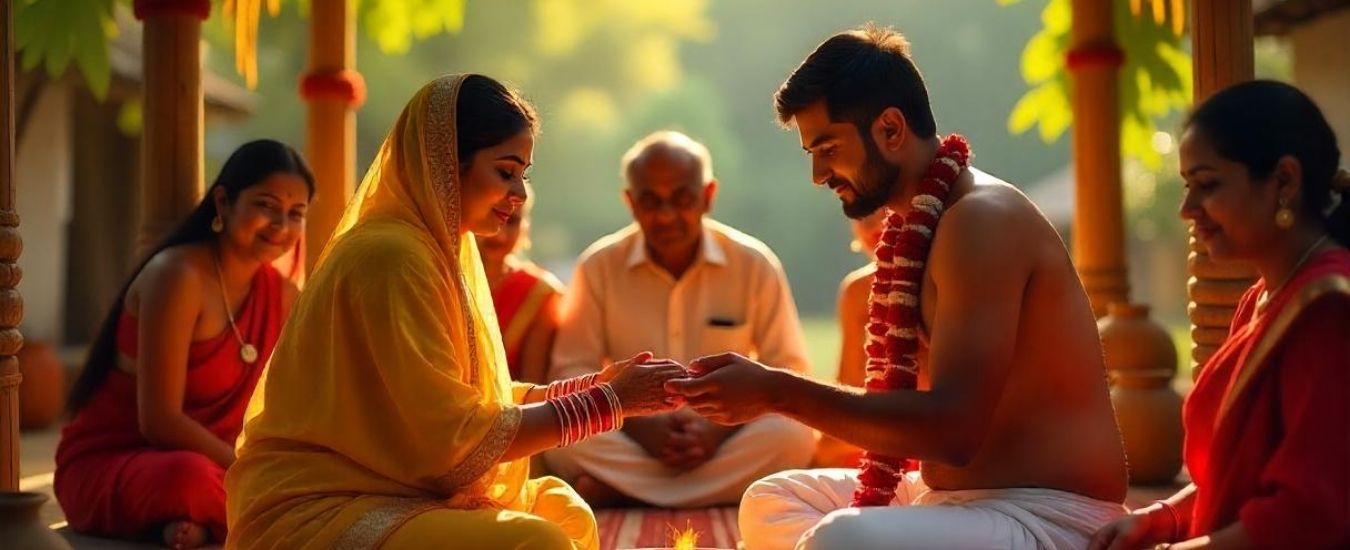An Assamese wedding is more than a ritual—it’s an immersive cultural celebration. It honors nature, respects tradition, and showcases community unity. Whether it’s the rhythmic Bihu beats or the soulful Saptapadi vows, every moment whispers heritage and harmony.
So, when you attend one, remember: you’re not just a guest—you’re part of a beautiful story. Let us explore with Aagrah Banquet.
A Spiritual Tapestry of Love and Heritage
Ever attended a wedding where everything feels spiritual, serene, and deeply rooted in nature? That’s the unique charm of an Assamese wedding. Unlike the glitz and glam of mainstream Indian weddings, these celebrations reflect a profound connection to culture, nature, and spirituality. Known for their grace, eco-friendly values, and ethnic vibrancy, Assamese shaadis blend age-old traditions with evolving modern trends.
Ethnic Influence and Religious Beliefs
Most Assamese weddings follow Hindu marriage traditions, especially Vaishnavism, focusing on devotion to Lord Vishnu. However, the region’s diversity—with communities like Bodo, Mishing, and Karbi—adds distinct rituals to each celebration. Wedding ceremonies often include prayers at the Naamghar and guidance by a Bhakat or Ojha (priest).
Pre-Wedding Rituals in Assamese Culture
Nuoni/Nuwoni – The Pre-Wedding Purification Ritual
This ceremony uses turmeric paste, mustard oil, and blessings from elders to cleanse and prepare the couple. The bride wears a traditional Gamosa around her shoulders for spiritual protection.
Juran Diya – The Sacred Gift Ceremony
The groom’s mother visits the bride with gold jewellery, clothes, and traditional Assamese sweets. She applies sindoor and gifts a Loka Paro, a jewel that symbolizes marital longevity.
Tel Diya – Nourishment and Prosperity Ritual
The bride’s hair is anointed with oil in the presence of elders while chanting blessings, invoking ancestral prosperity.
Assamese Wedding Attire and Accessories
Bride’s Look – Mekhela Chador & Gold Elegance
The bride dazzles in Mekhela Chador, usually of Muga silk, Kesa Paat, or Pat silk, adorned with Junbiri, Gamkharu, and traditional red bangles.
Groom’s Traditional Outfit
He wears a white dhoti, kurta, and silk Chadar, paired with a red Gamosa, symbolizing respect and identity.
Wedding Day Rituals
Arrival of the Groom – Bor Jatri
The groom’s entourage, known as Bor Jatri, enters with rhythmic music, often led by traditional dhol players and Bihu dancers.
Welcoming the Groom – Aarti and Purification
The bride’s family welcomes him with an aarti, milk and water foot washing, and sweet offerings like Jolpan.
Wedding Mandap and Vows
The sacred wedding mandap is set using banana leaves, earthen pots, and floral décor. Vows are guided by an Ojha, chanting Vedic mantras.
Symbolic Rituals
- Xoru Xoru Mala: A minimalist exchange of tulsi bead garlands.
- Lakhi Jora: A compatibility ritual based on destiny and astrology.
- Saptapadi: The couple takes seven sacred rounds around the fire, vowing mutual respect, spiritual unity, and lifelong support.
Post-Wedding Rituals
Bidaai – Farewell from Parental Home
A deeply emotional moment when the bride leaves, receiving blessings and a silver coin wrapped in Gamosa for protection.
Ghor Gosoka – Welcome to New Home
She steps on rice grains, signifying prosperity, and is welcomed with Assamese wedding songs.
Saanti Biya – Reenactment with Fun
A mock wedding with jokes, pranks, and traditional games, symbolizing happiness and removing negative energy.
Food and Festivities
Traditional Assamese Wedding Cuisine
A wedding feast includes Masor Tenga, Duck Curry, Khar, Xaj (rice beer), Pitha, and Payox, often served on eco-friendly plates made of sal leaves.
Bihu and Folk Performances
Weddings feature live Bihu dance, Pepa instrumentals, and regional songs performed by local troupes.
Symbolism and Community Involvement
Role of Elders and Community Leaders
Blessings from elders, Bhakats, and family heads are considered sacred. Community leaders also act as legal and cultural witnesses under Assamese marriage laws.
Nature and Simplicity
The bond with nature is seen through minimalist decoration, locally sourced flowers, and handwritten Assamese wedding invitation cards using recycled paper.
Modern Influences on Assamese Weddings
Tradition Meets Innovation
Modern couples blend age-old customs with wedding planners, photographers, pre-wedding shoots, and designer silk Mekhelas while staying rooted in religious and cultural practices.
Eco-Friendly Trends
From Xaj served in bamboo tumblers to zero-plastic décor, Assamese weddings are pioneering sustainable celebrations in India.
FAQs
What is the most important ritual in an Assamese wedding?
The Saptapadi (seven rounds around the fire) and the Nuoni purification ritual are among the most important, symbolizing commitment and spiritual cleansing.
What do Assamese brides wear during the wedding?
They wear a traditional Mekhela Chador, usually made of Muga silk, along with traditional Assamese jewellery.
How long do Assamese wedding celebrations usually last?
Typically, celebrations span 2 to 3 days, including pre-wedding, wedding day, and post-wedding rituals.
Do Hindu traditions influence Assamese weddings?
Yes, most are deeply rooted in Hindu rituals, especially those from Vaishnavism, but they also include unique Assamese customs.
What makes Assamese wedding food special?
The cuisine is a delicious mix of local flavors, often featuring organic ingredients, traditional spices, and unique dishes like Khar, Duck Curry, and Pithas.
